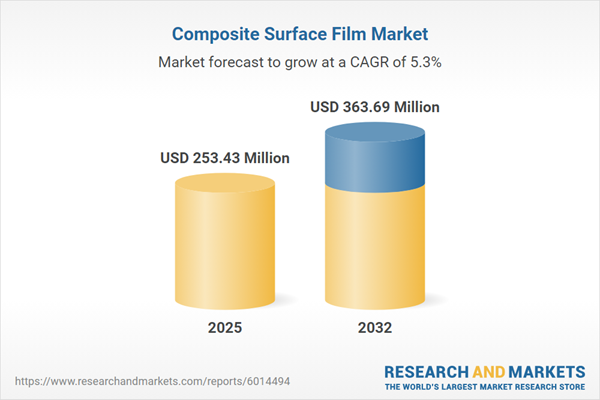Speak directly to the analyst to clarify any post sales queries you may have.
Composite surface films are transforming industry expectations for performance, protection, and design flexibility by advancing the possibilities in coatings and engineered surfaces across aerospace, electronics, automotive, and manufacturing. As senior decision-makers seek solutions that balance regulatory, operational, and market demands, the composite surface film market delivers strategic opportunities for product innovation and competitive differentiation.
Market Snapshot: Composite Surface Film Market Growth & Outlook
The composite surface film market grew from USD 240.39 million in 2024 to USD 253.43 million in 2025, with a projected compound annual growth rate (CAGR) of 5.31%. By 2032, market value is expected to reach USD 363.69 million.
Expansion is closely tied to innovation in deposition processes, demand from advanced manufacturing sectors, and increasing focus on regulatory compliance and material sustainability.Scope & Segmentation: Capturing Opportunities in the Composite Surface Film Market
- Technology: Chemical vapor deposition, electroplating, physical vapor deposition, sol-gel processes, sputtering, and thermal spraying are central techniques empowering market differentiation.
- Category: Coatings are segmented as decorative, functional (including anti-corrosion, anti-graffiti, anti-reflective, anti-scratch, and non-stick), and protective, each supporting distinct performance objectives across industries.
- Application: Markets analyzed include aerospace and defense, automotive, construction, electronics, industrial machinery, and medical devices, reflecting a broad landscape of end-use innovation.
- Material: Substrates range among ceramics, composites, metals, and polymers, enabling tailored solutions that meet sector-specific durability, functionality, and compliance requirements.
- Thickness: Products are categorized by standard, thick, and ultrathin films, supporting requirements from robust mechanical strength to advanced miniaturization.
- Regions: Key geographic markets include Americas (North America: United States, Canada, Mexico; Latin America: Brazil, Argentina, Chile, Colombia, Peru); Europe, Middle East & Africa (Europe: United Kingdom, Germany, France, Russia, Italy, Spain, Netherlands, Sweden, Poland, Switzerland; Middle East: United Arab Emirates, Saudi Arabia, Qatar, Turkey, Israel; Africa: South Africa, Nigeria, Egypt, Kenya); Asia-Pacific (China, India, Japan, Australia, South Korea, Indonesia, Thailand, Malaysia, Singapore, Taiwan).
- Leading Companies: Analysis covers 3M Company, Avery Dennison Corporation, PPG Industries, Inc., Nitto Denko Corporation, tesa SE, Henkel AG & Co. KGaA, Sika AG, Berry Global, Inc., H.B. Fuller Company, and Lohmann GmbH & Co. KG.
Key Takeaways for Senior Decision-Makers
- Composite surface films play a critical role in enhancing product lifecycles, reducing maintenance, and supporting material light-weighting across highly regulated industries.
- Technological evolution, particularly in deposition techniques, enables manufacturers to deliver customized coatings that address emerging needs for performance, aesthetics, and environmental compliance.
- Electronics and electric vehicle market growth are accelerating demand for advanced films, focusing on insulation, corrosion resistance, and thermal management.
- Shifting end-user requirements and stricter environmental mandates are catalyzing investments in sustainable materials and solvent-free processes.
- Integration of digital monitoring, real-time process control, and predictive maintenance provides opportunities for operational improvements and robust quality assurance in production workflows.
Tariff Impact: Navigating Cost and Supply Chain Shifts in Composite Surface Films
The introduction of United States tariffs in 2025 has prompted composite surface film producers to adapt sourcing strategies, strengthen domestic capacities, and reconsider supplier relationships to preserve competitiveness and supply reliability. These changes have led end-users in sectors such as automotive and consumer electronics to implement material substitutions and inventory management measures as part of broader cost-mitigation efforts. Policy developments remain central to supply chain planning and strategic risk management.
Methodology & Data Sources
This report utilizes a robust research approach, integrating primary interviews with industry experts and stakeholders worldwide, and systematic secondary reviews of patents, technical publications, and trade data. Data triangulation ensures accuracy, while regional expert workshops refine recommendations and validate trends.
Why This Report Matters for Composite Surface Film Market Stakeholders
- Enables strategic planning by mapping market drivers, barriers, and competitive dynamics across segments and regions.
- Equips leadership teams with actionable, granular insights on technology adoption, regulatory trends, and sector-specific opportunities.
- Supports informed investment, supply chain alignment, and partnership decisions in a rapidly changing regulatory and technology environment.
Conclusion: Strategic Direction for Growth
Sustained advancement in composite surface film technology, coupled with proactive supply chain and regulatory strategies, positions market participants for long-term, value-driven growth. Informed decision-making powered by this report will enable senior leaders to capitalize on change and drive differentiated outcomes across sectors.
Additional Product Information:
- Purchase of this report includes 1 year online access with quarterly updates.
- This report can be updated on request. Please contact our Customer Experience team using the Ask a Question widget on our website.
Table of Contents
3. Executive Summary
4. Market Overview
7. Cumulative Impact of Artificial Intelligence 2025
Companies Mentioned
The companies profiled in this Composite Surface Film market report include:- 3M Company
- Avery Dennison Corporation
- PPG Industries, Inc.
- Nitto Denko Corporation
- tesa SE
- Henkel AG & Co. KGaA
- Sika AG
- Berry Global, Inc.
- H.B. Fuller Company
- Lohmann GmbH & Co. KG
Table Information
| Report Attribute | Details |
|---|---|
| No. of Pages | 196 |
| Published | November 2025 |
| Forecast Period | 2025 - 2032 |
| Estimated Market Value ( USD | $ 253.43 Million |
| Forecasted Market Value ( USD | $ 363.69 Million |
| Compound Annual Growth Rate | 5.3% |
| Regions Covered | Global |
| No. of Companies Mentioned | 11 |









